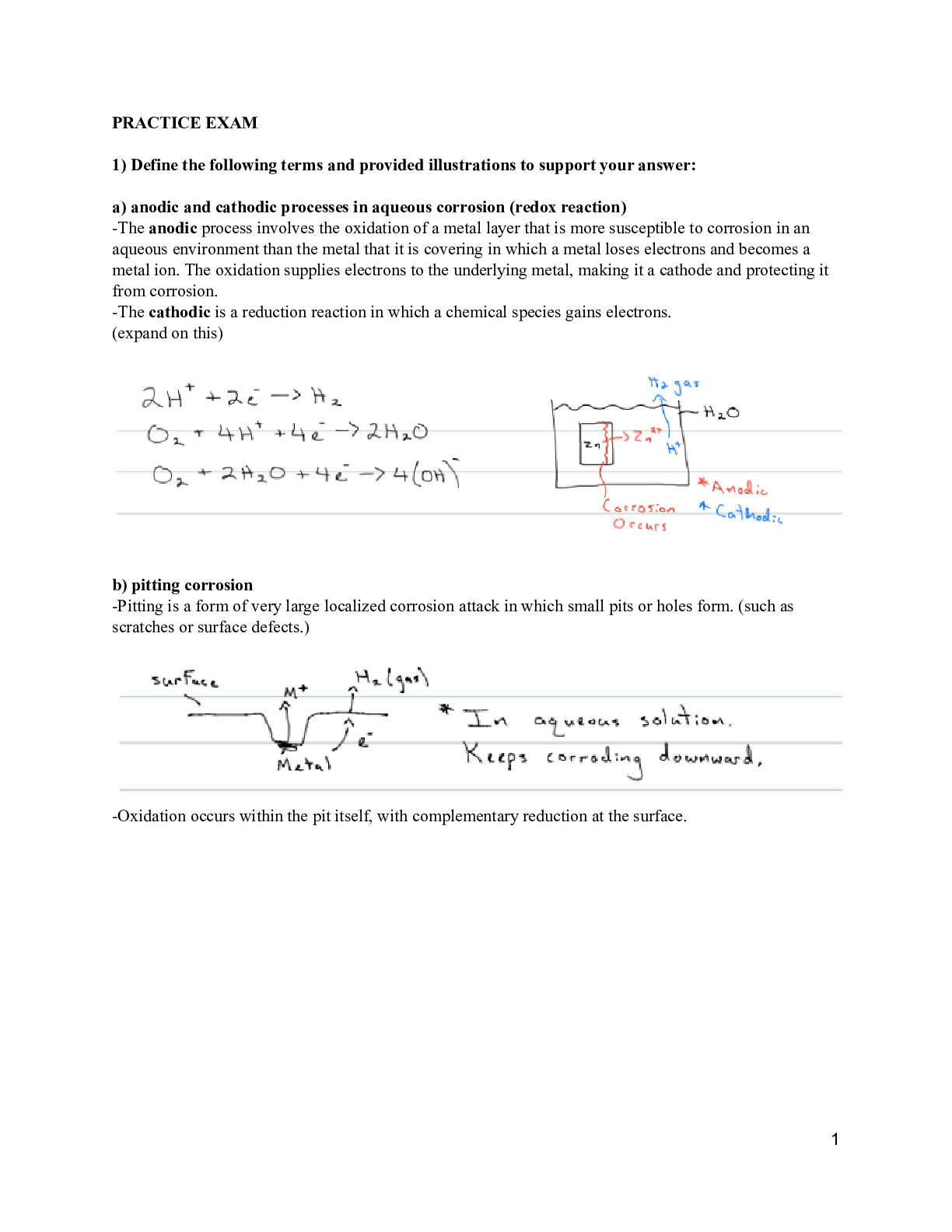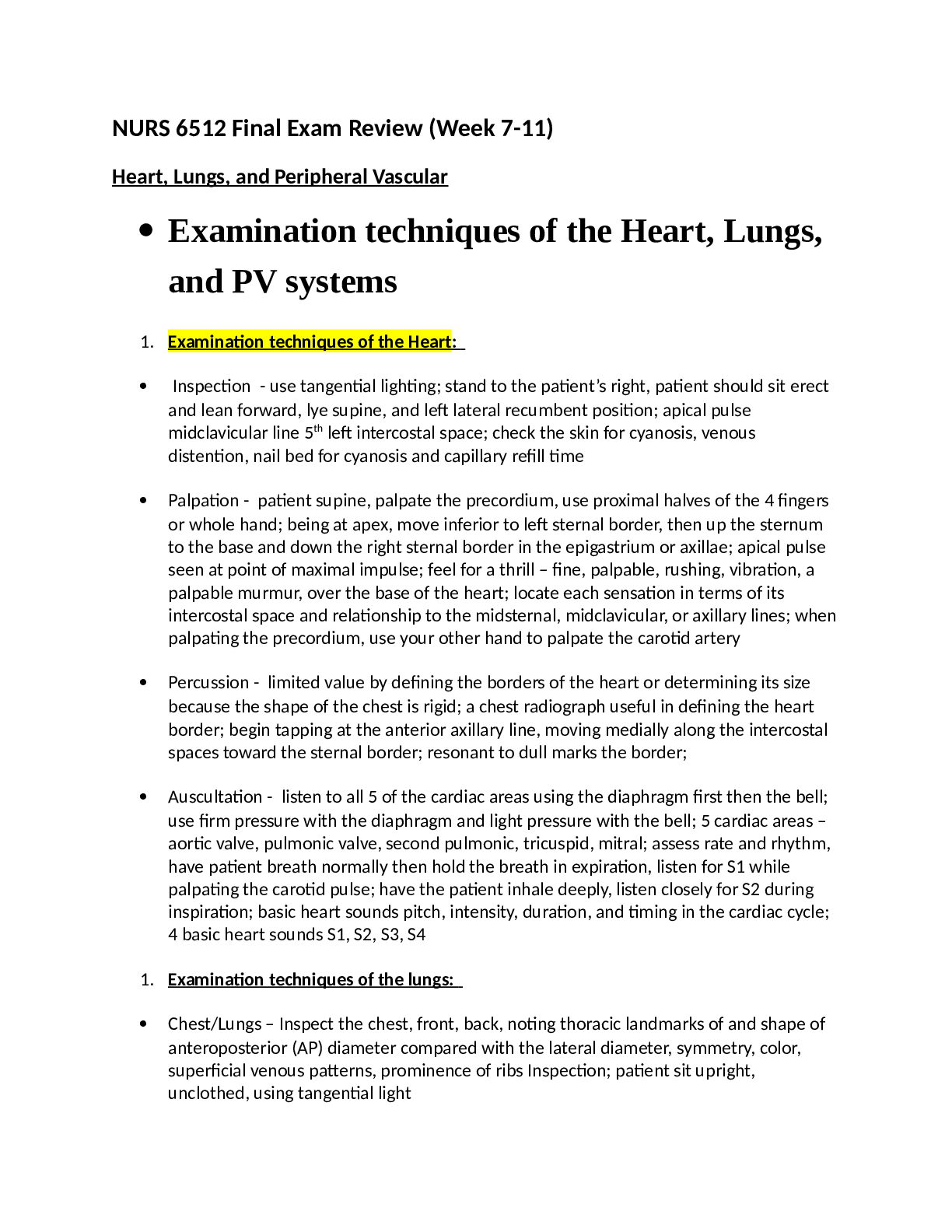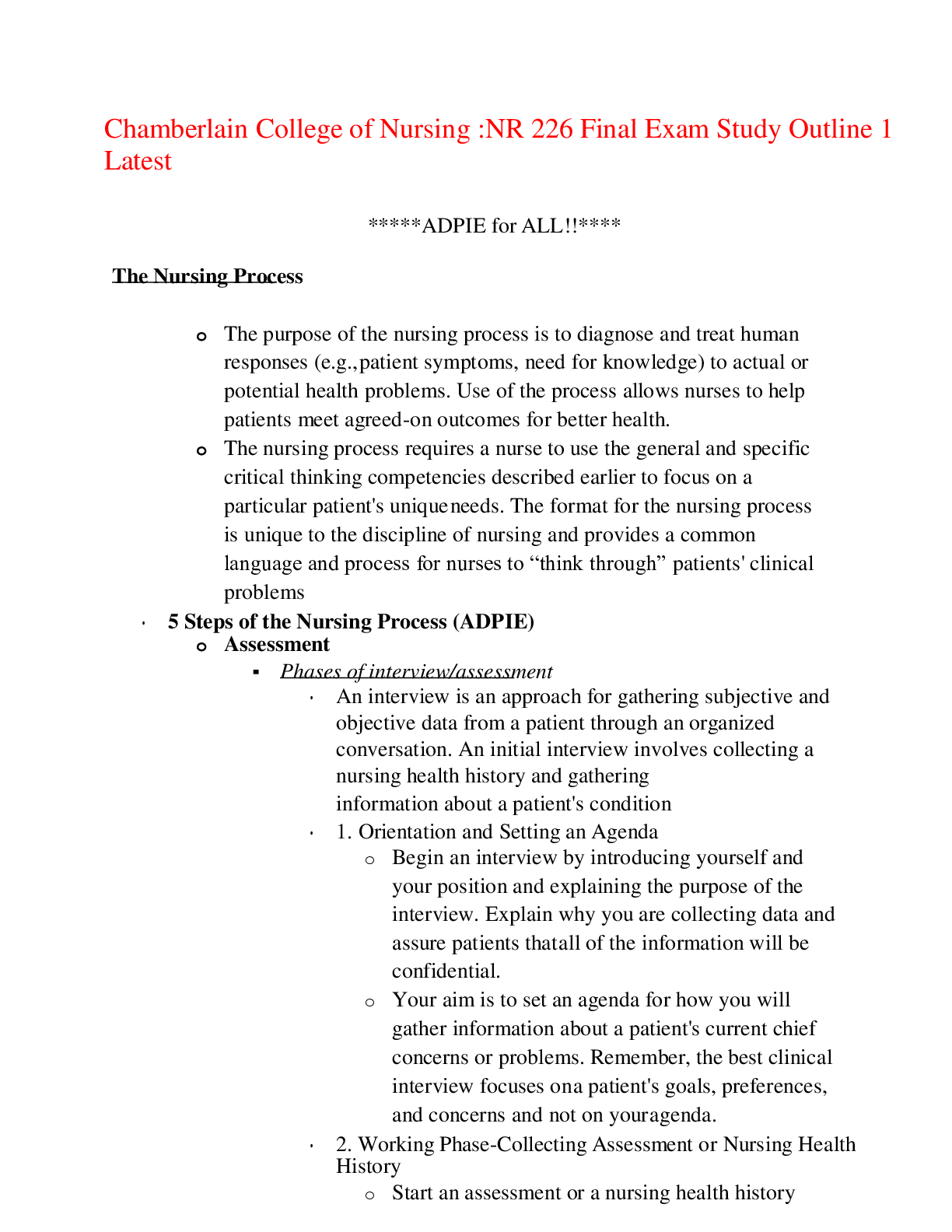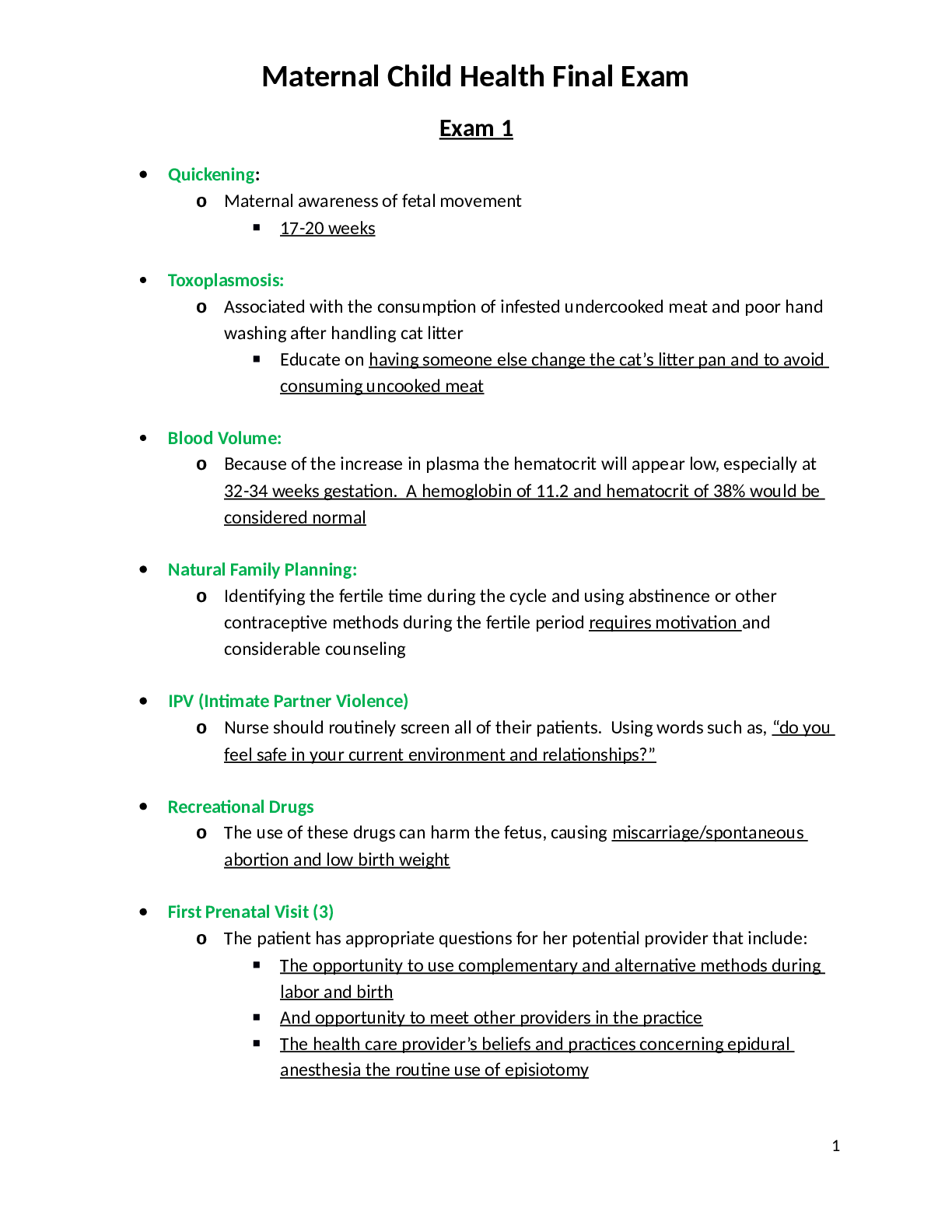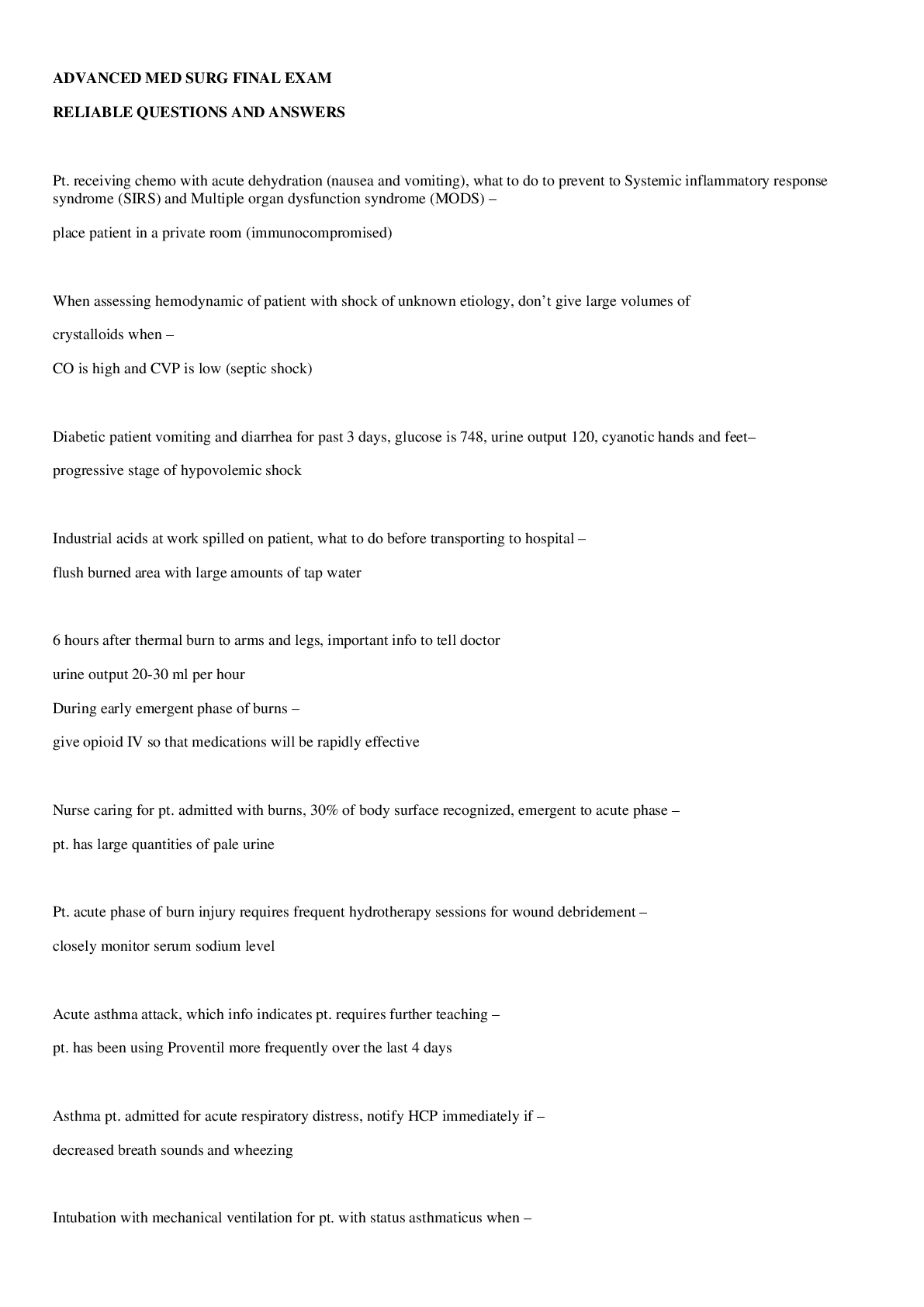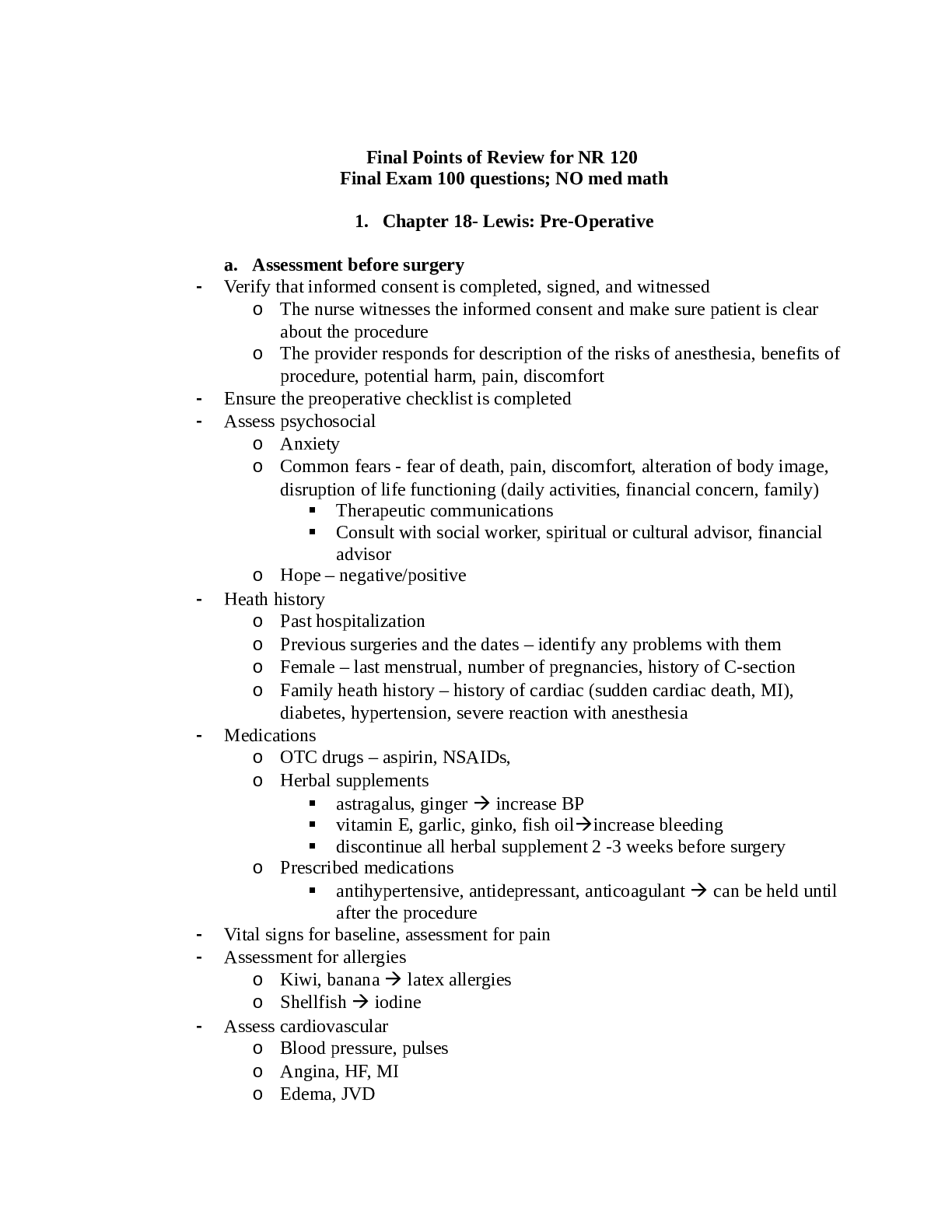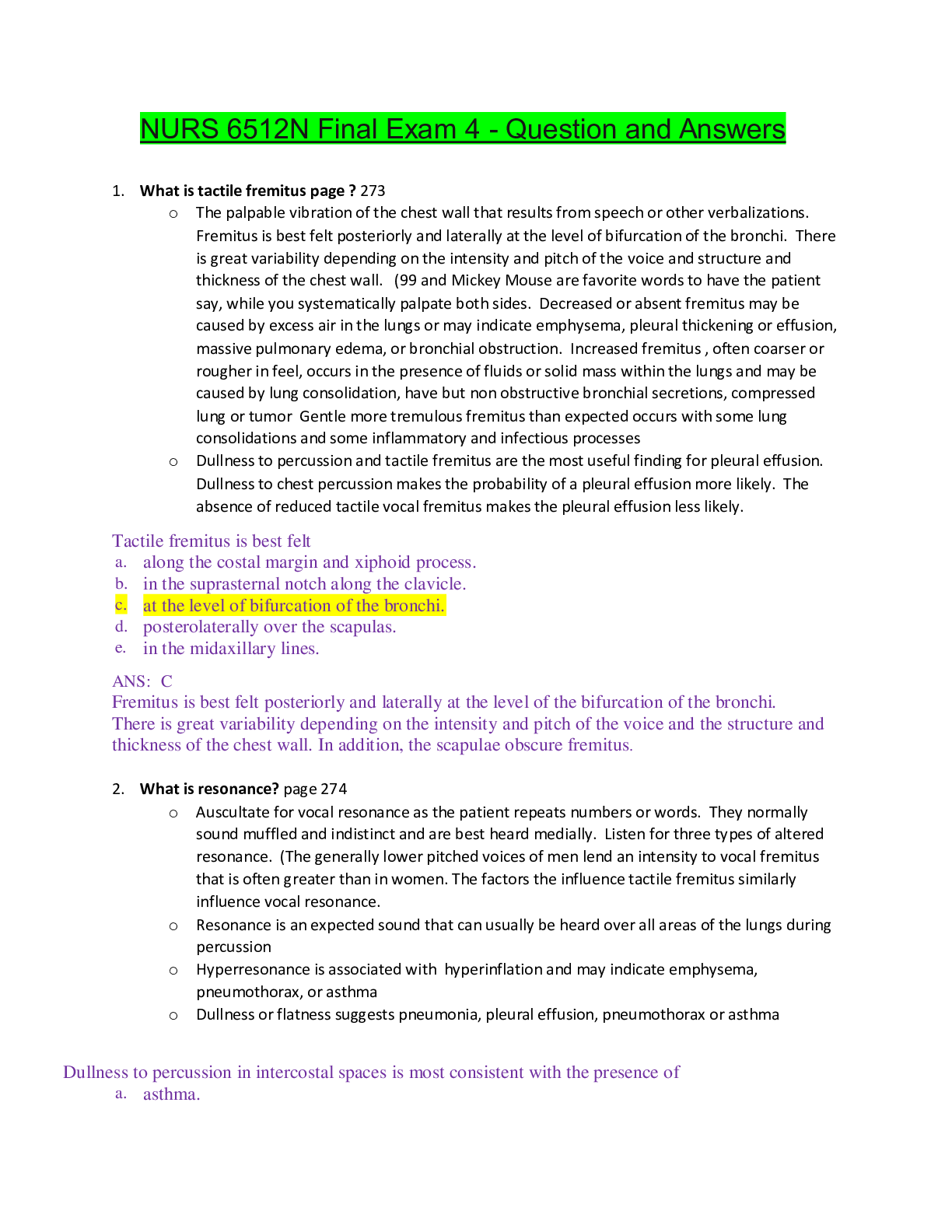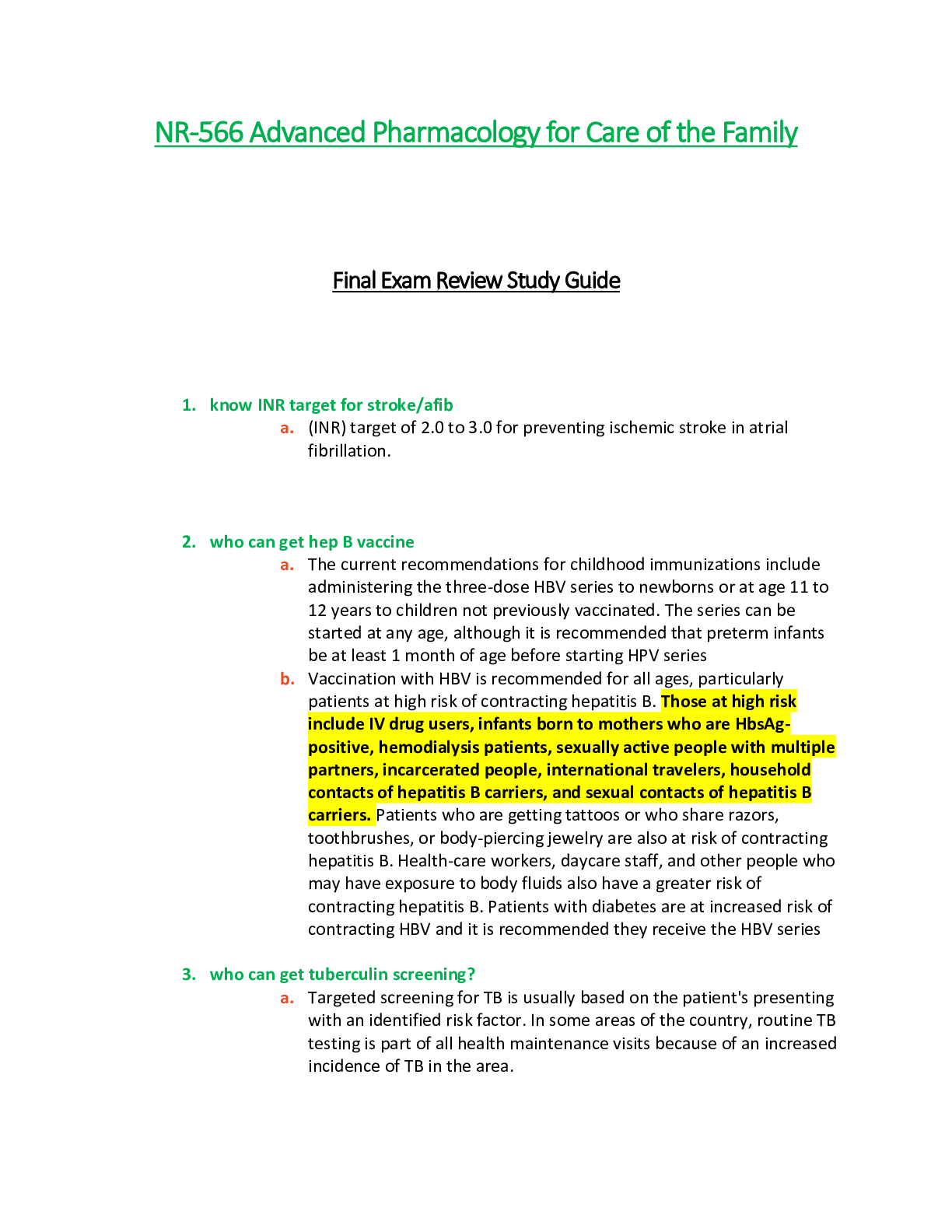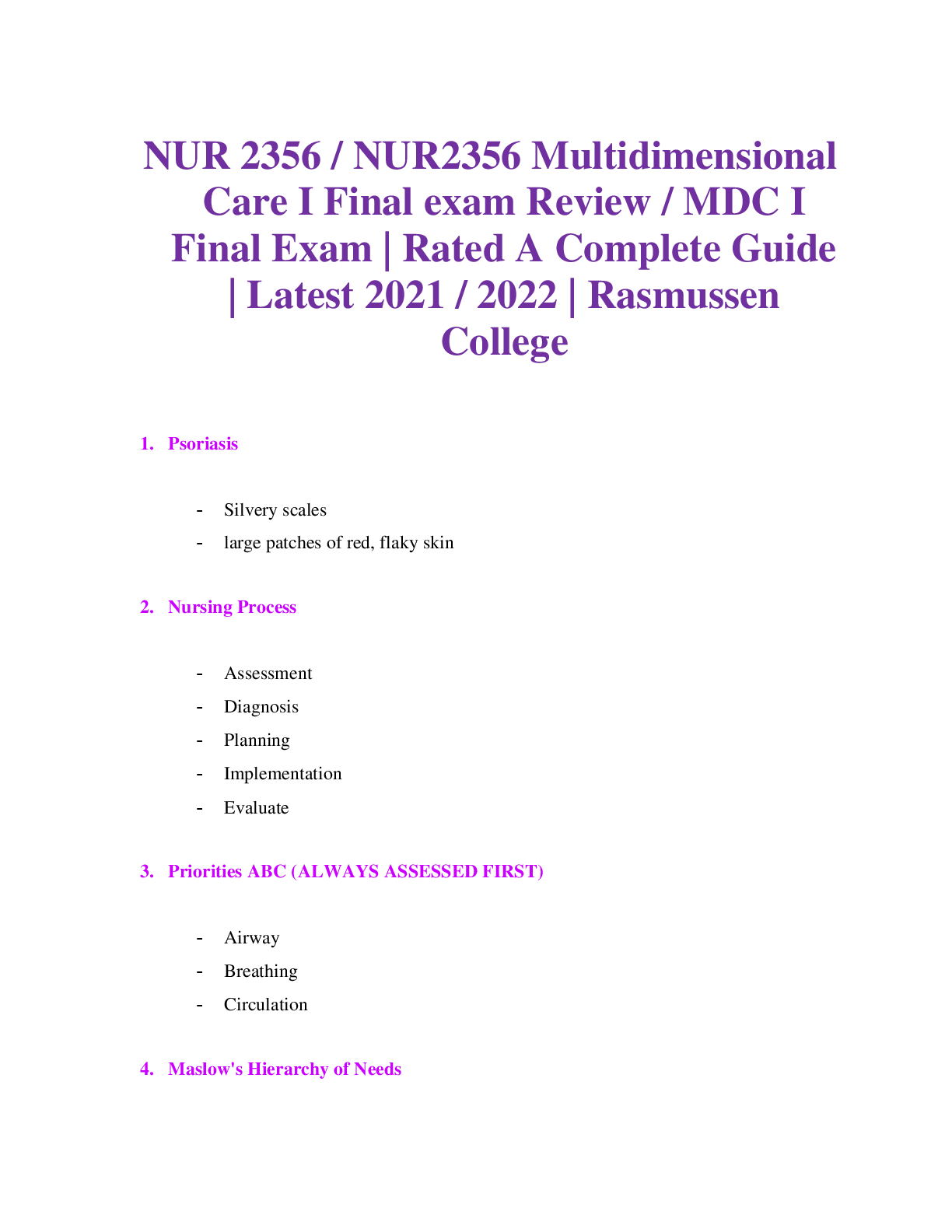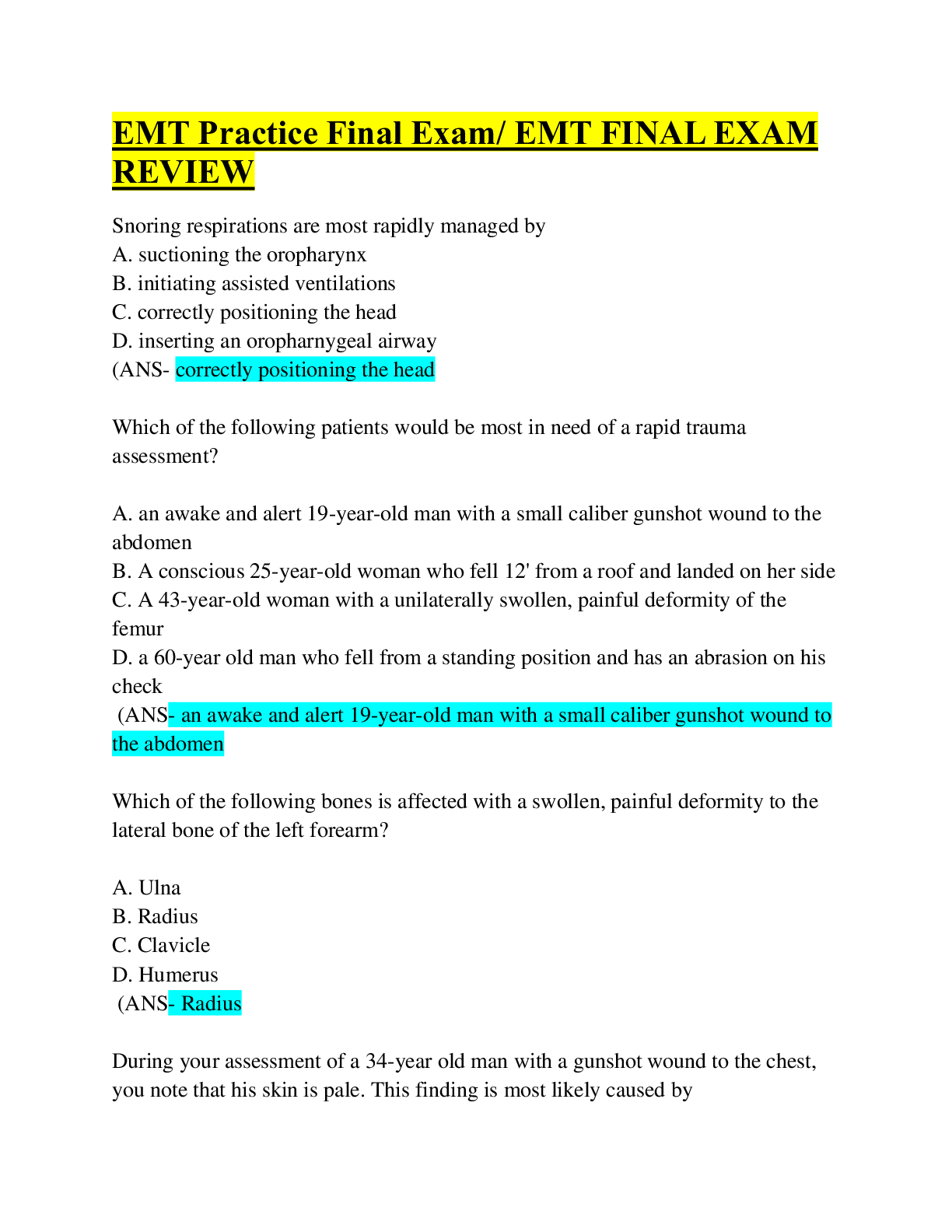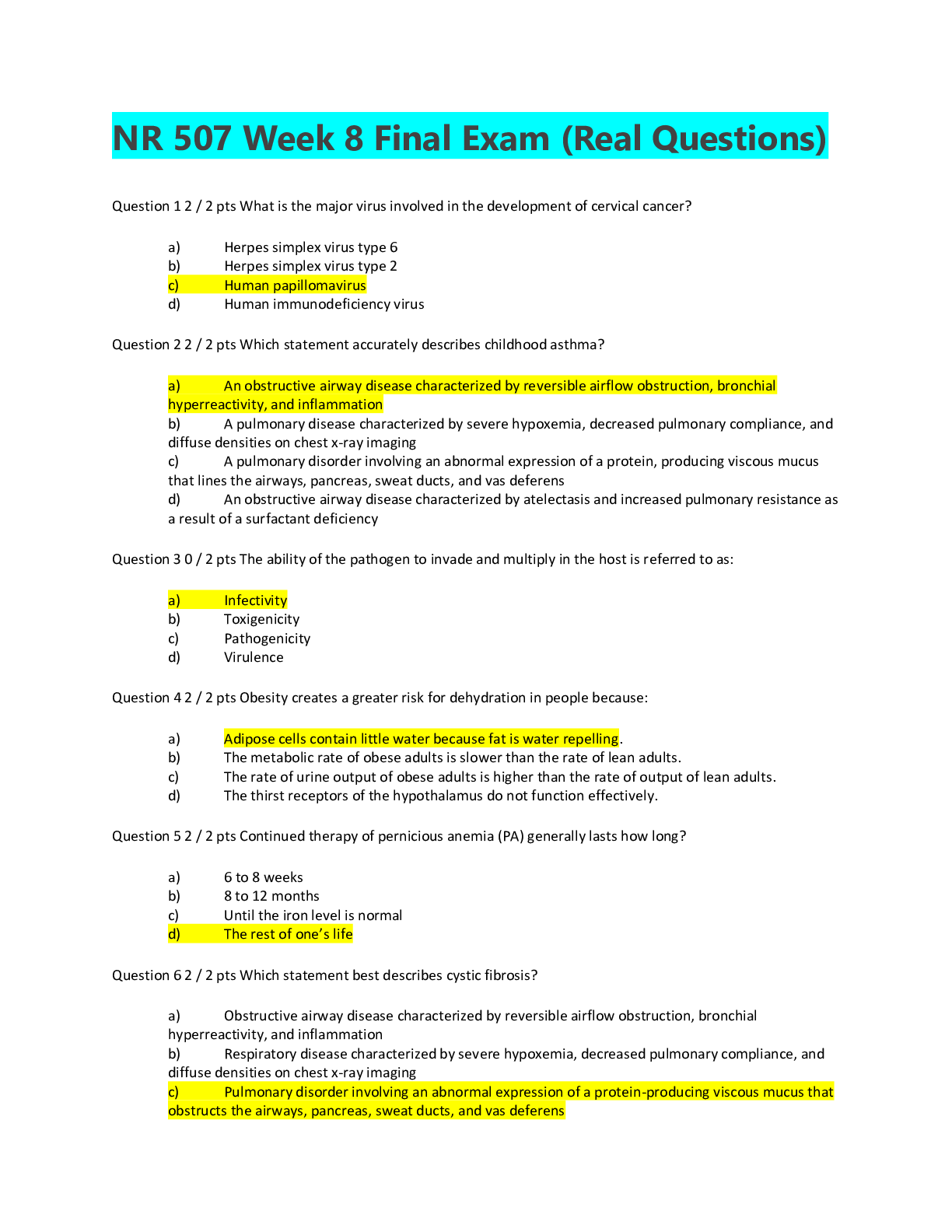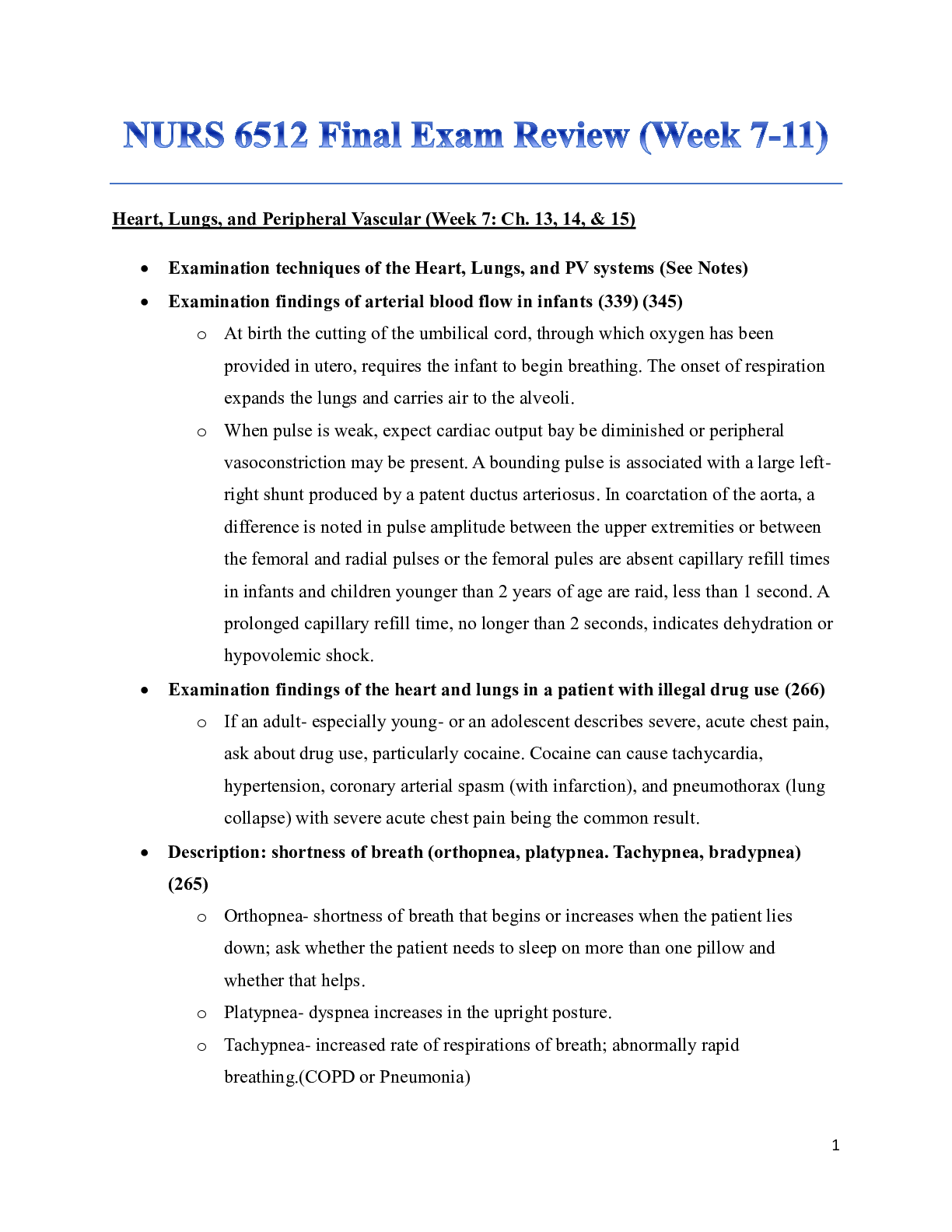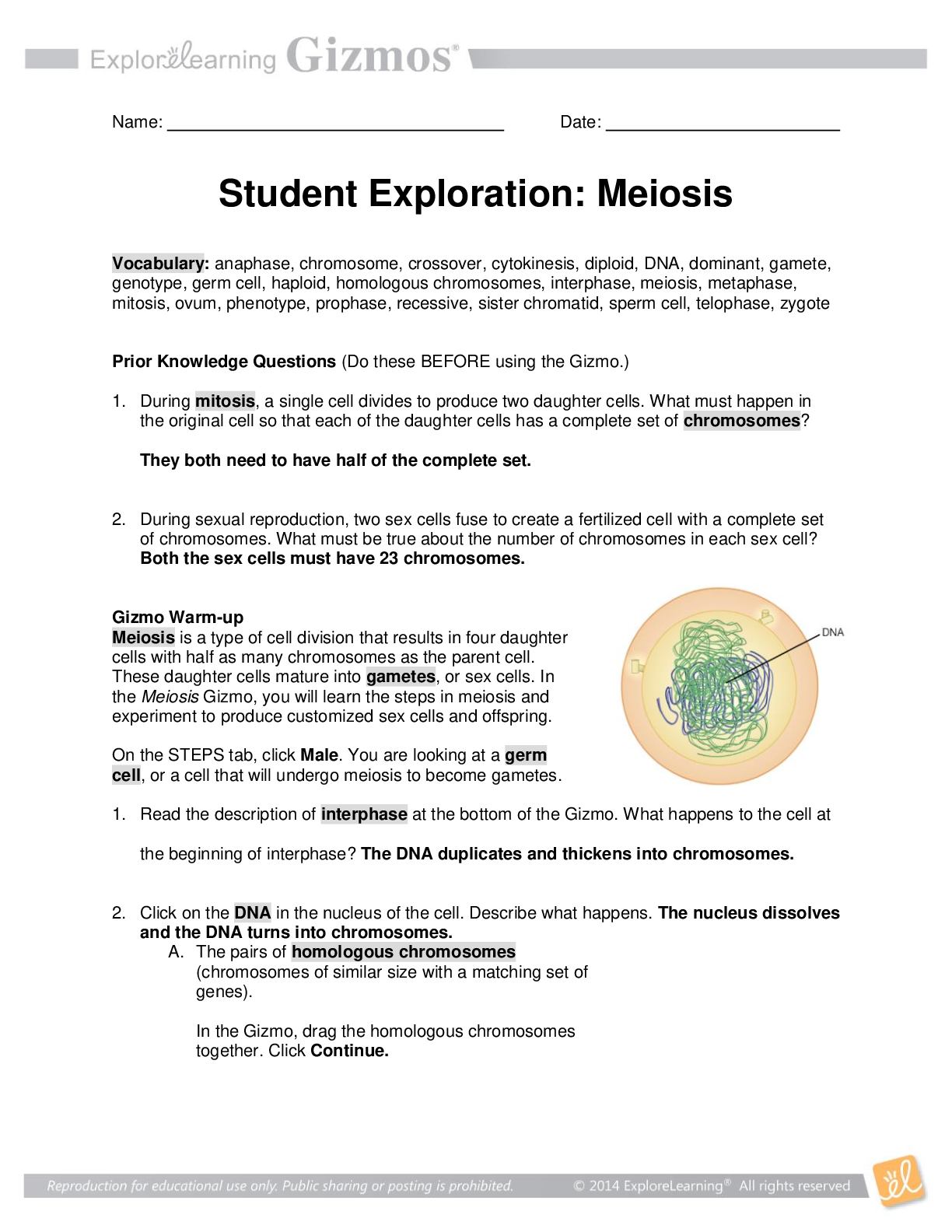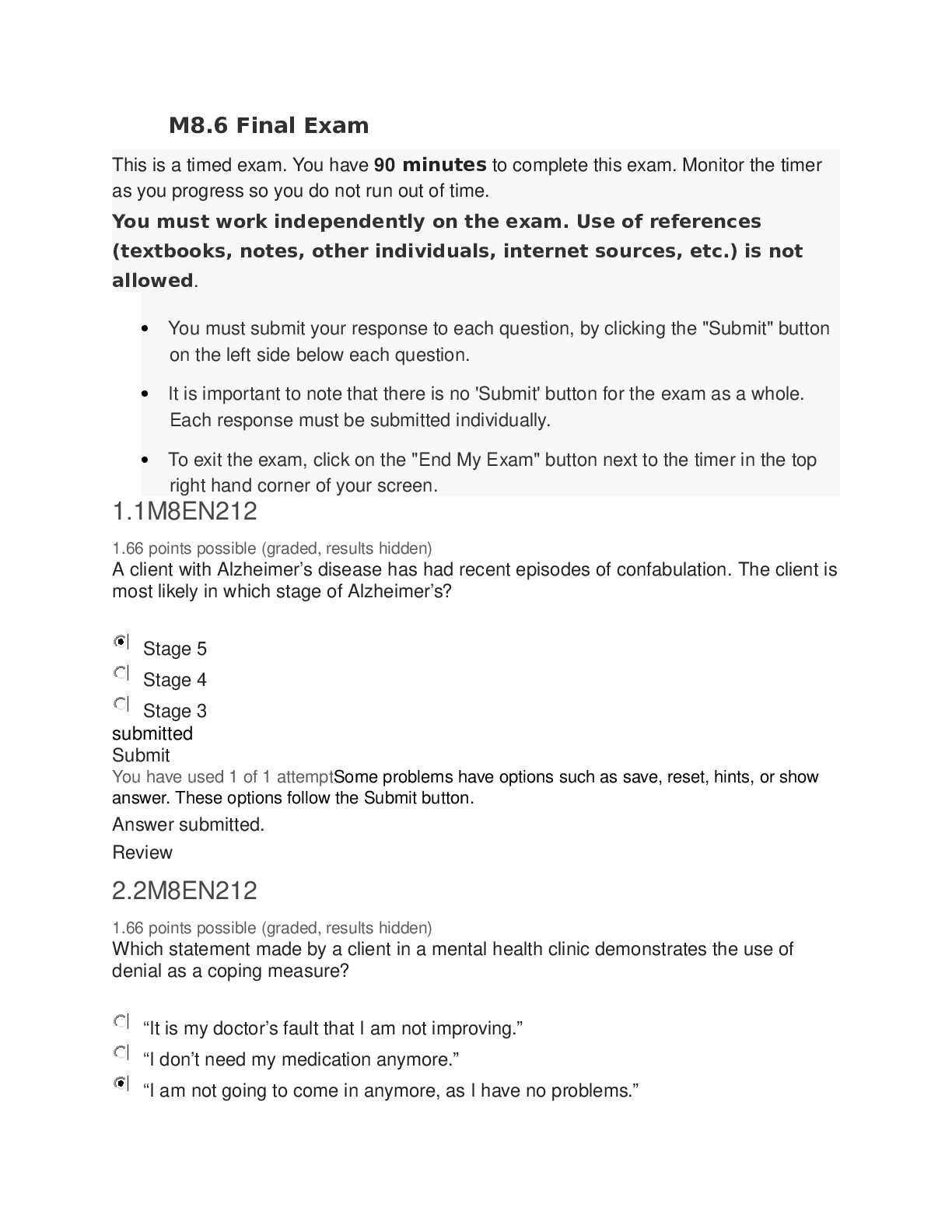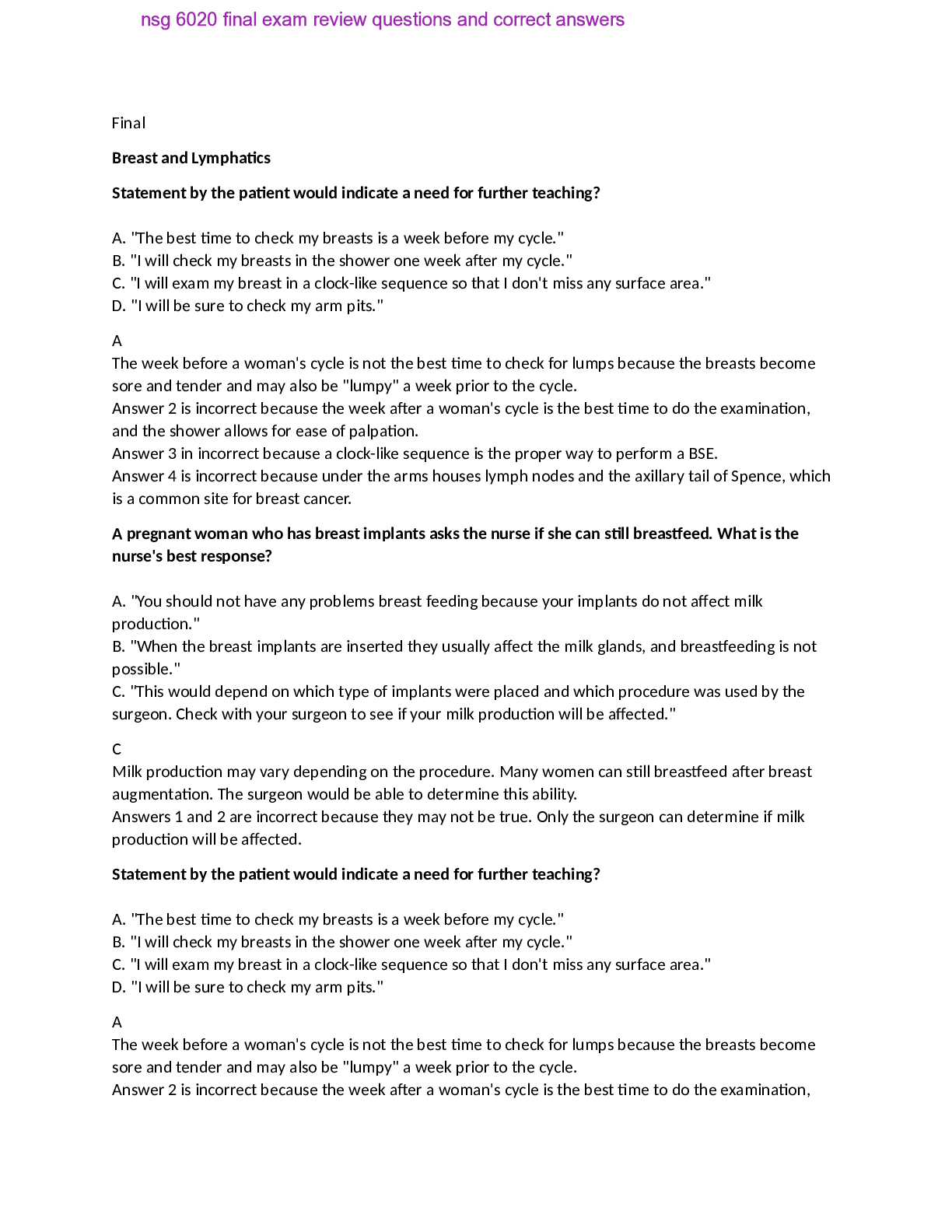Medical Studies > Final Exam Review > HIV& Hematology and Neurologic & Auditory Problems Summary (for final exam) A+ Guide (All)
HIV& Hematology and Neurologic & Auditory Problems Summary (for final exam) A+ Guide
Document Content and Description Below
HIV How do we diagnosis HIV? (p.235) Done by testing for HIV antibodies and/or antigen in the blood. HIV antibody tests detect HIV specific antibodies Diagnosis of HIV is made by testing for HIV ... antibodies and/or antigen in the blood. What is the difference in the ELISA and Western Blot? A highly sensitive enzyme immunoassay is done to detect serum antibodies that bind to HIV antigens on test plates. Western blot confirms Elisa Which test is needed for confirmation? Western blot Who do we test? Can the infection be transmitted at any time? Gays, women, people of color, people who live in poverty, and adolescents HIV CANNOT spread casually. The virus cannot be transmitted through hugging, dry kissing, shaking hands, sharing eating utensils, using toilet seats, or casual encounters in any setting. It is not spread by tears, saliva, urine, emesis, sputum, feces, sweat, respiratory droplets, or enteric routes. HIV can be transmitted as a result of contact with infected blood, semen, vaginal secretions, or breast milk. HIV occurs through sexual intercourse with an infected partner, exposure to HIV infected blood or blood products; and perinatal transmission during pregnancy, at delivery, or through breast feeding. Spread most commonly by unprotected sexual contact with an HIV infected partner. Sexual activity involves contact with semen, vaginal secretions, and/or blood, all of which have lymphocytes that may contain HIV. Can also be transmitted through blood borne organisms, and sharing the equipment can result in disease transmission. Puncture wounds are the most common means of work related HIV transmission. Perinatal transmission from an HIV infected mother to her infant can occur during pregnancy, delivery, or breastfeeding. What are clinical Manifestations of HIV? ACUTE: fever, swollen lymph glands, sore throat, headache, malaise, nausea, muscle joint pain, diarrhea, and/or a diffuse rush often accompanies. May also develop neurologic complications, aseptic meningitis, peripheral neuropathy, facial palsy, Gillian barre syndrome. Most signs and symptoms are asymptomatic, fatigue, headache, low grade fever, night sweats, persistent generalized lymphadenopathy, and other symptoms may be present. Candida organisms are more common in HIV infected people. KS, oral hairy leukoplakia and other infectious diseases (p. 234) Early (generalized lymphadenopathy) vs. Intermediate vs. late chronic or AIDS??? EARLY: symptoms are vague and nonspecific, people may not be aware that they are infected. During this time people continue their usual activities, which may include high risk sexual and drug using behaviors. Intermediate-a cd4 t count drops to 200-500 and the viral load increases, HIV advances to a more active stage. Symptoms seen in earlier phases become worse, leading to persistent fever, drenching night sweats, chronic diarrhea, recurrent headaches, and fatigue severe enough to interrupt normal routines. Localized infections, lymphadenopathy, and nervous system manifestations. Late/chronic/AIDS- person already had HIV and develops one of the 5 conditions for AIDS diagnosis (listed below) What is the criteria for an AIDS diagnosis? i.e. CD4 <200 --- or ??? Table 15-9 page 235: 1. CD4 T cell drops below 200 cells ml 2. one of the following opportunistic infections: fungal- candidiasis of bronchi, trachea, lungs, or esophagus; Pneumonia Viral- cytomegalovirus other than liver, spleen, or nodes, CMV; herpes, bronchitis, pneumonitis, progressive multifocal leukoencephalopathy protozoal- toxoplasmosis of the brain, chronic intestinal isopsoriasis Bacterial- TB, mycobacterium avium complex, recurrent salmonella 3. One of the following cancers: Invasive cervical cancer Kaposi sarcoma Burkett’s lymphoma Immunoblastic lymphoma Primary lymphoma of the brain 4. Wasting syndrome-a loss of 10% or more of ideal body mass 5. AIDS dementia complex What is the purpose of Anti-retroviral drugs? Anti-retroviral therapy delays disease progression by decreasing viral replication. When taken consistently and correctly, ART can reduce viral loads by 90% to 99%, which makes adherence to treatment regiments extremely important. Decrease viral RNA levels (viral load)??? Yes, when taken consistently reduces loads by 90-99% What do you need to teach your patients about these meds? Many have dangerous and potentially lethal interactions with other commonly used drugs, including OTC drugs and herbal therapies (p240) If we question compliance should a patient begin ART? No, adherence is a critical component of successful drug therapy. Missing even a few doses can lead to drug resistance. Are there any side effects of these meds? i.e. AZT—aplastic anemia? Yes there can be many side effects, metabolic disorders, and changes in body shape, fat deposits in the abdomen, upper back, and breasts along with fat loss in the arms, legs, and face. Hyperlipidemia, elevated ldls, elevated tris, decreased hdls, hyperglycemia, insulin resistance, bone disease, lactic acidosis, renal disease, cardiovascular disease. How do we assess effectiveness of ART therapy? --- check viral load??? After 2-4 weeks on drug therapy your health care provider will check your viral load What if the viral load is undetectable—can a patient still transmit? It does not mean that the virus is gone, it can live in lymph nodes and organs that blood tests cannot detect. You are still able to transmit HIV to others. What teaching would you do with your patient? Reduce any risks, safe sex, abstaining from sex, do not sue drugs, do not share equipment, do not have sexual intercourse under the influence What would you tell a patient who is pregnant about likelihood of transmission to her baby? If HIV infected pregnant women are appropriately treated during pregnancy, the rate of perinatal transmission can be decreased from 25% to less than 2%. Art has significantly decreased the risk for infants born to HIV infected women, and more of these women are now becoming mothers. CHAPTER 30 Hematology What are the normal lab values for a CBC: Hgb: Women: 11.7-17.3 g/dL Men: 13.2-17.3 g/dL Hct: Women 35%-50%/ 0.35-0.50 Men: 39 – 50% WBC: 4,000 – 11,000 / microL >11,000 - infection, inflammation, tissue injury or death, and malignancies. <4000 - bone marrow depression, severe or chronic illness, and some leukemias. RBC: 3.8-5.7 Platelets: 150,000-400,000/microL What does a low RBC count mean? Anemia, pancytopenia/aplastic anemia, chronic hemolytic anemia, What if Hgb is low? Anemia, hemorrhage, and hemodilution, fluid volume is excessive Why would WBC be elevated? - Infection, inflammation, tissue injury or death, and malignancies Why would WBC be low?? Bone marrow depression, severe or chronic illness, and some types of leukemia. Compromised immune function—ex AIDS, Chemo patient What is a shift to left? Severe Infection??? Immature neutrophils or bands are elevated. When infections are severe more granulocytes are released from the bone marrow as a compensatory mechanisms. To meet the increased demand, many young, immature polymorphonuclear bands are released into circulation. The usual lab procedure is to report the wbcs in order of maturity, with the less mature forms on the left side of the written report. Consequently, the existence of many immature cells is termed shift to the left. What is neutropenia? How do we manage a neutropenic patient? It is a condition in which the absolute neutrophil count is less than 1000; this is due to a number of disease processes, such as leukemia, or from bone marrow depression. Monitor the neutropenic patient for signs and symptoms of infection (e.g., any fever 100.4° F [38° C] or greater) and early septic shock. Early identification of a potentially infective organism depends on acquiring cultures from various sites. The patient with neutropenia is predisposed to infection with opportunistic pathogens and nonpathogenic organisms from the normal body flora. When the WBC count is depressed/immature WBC’s are present, normal phagocytic mechanisms are impaired. The classic signs of inflammation—redness, heat, and swelling—may not occur. Because WBC’s are the major component of pus in patients with neutropenia, pus formation is also absent. CHAPTER 31 Anemia: What are the clinical manifestation [Show More]
Last updated: 1 year ago
Preview 1 out of 17 pages

Reviews( 0 )
Document information
Connected school, study & course
About the document
Uploaded On
Jul 03, 2021
Number of pages
17
Written in
Additional information
This document has been written for:
Uploaded
Jul 03, 2021
Downloads
0
Views
87


